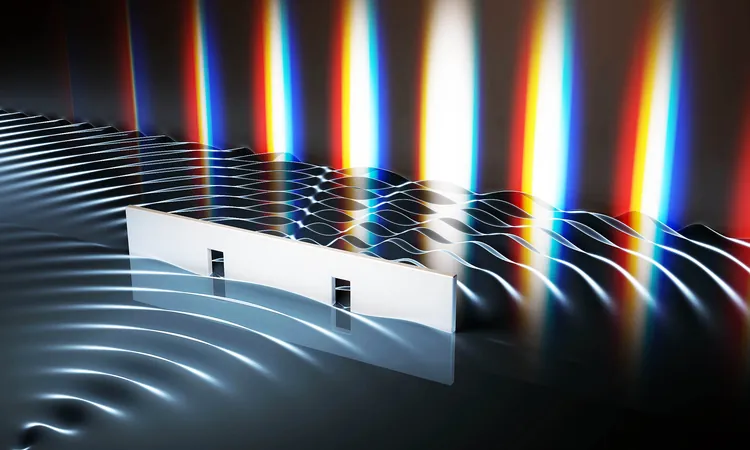
Revolutionary ‘Dark Photon’ Theory Could Shatter Centuries of Quantum Understanding
2025-05-13
Author: Wei
A Paradigm Shift in Light Physics
For centuries, the scientific community has accepted the dual nature of light, behaving both as a wave and a particle—a cornerstone of quantum mechanics. This belief was significantly bolstered by the famous double-slit experiment, demonstrating wave-like interference. However, a groundbreaking new study suggests that we're just scratching the surface of what light truly is.
The New Research Unveiled
Led by Gerhard Rempe at the Max Planck Institute for Quantum Optics, a team of researchers from the Federal University of São Carlos and ETH Zurich propose that interference patterns traditionally attributed to light as a wave may also be explained using quantum particles alone. Their findings open the door to a new understanding, challenging the longstanding perceptions of light.
From Waves to Quantum Particles
The traditional view of light dates back to 1801, when Thomas Young performed an experiment demonstrating light’s wave-like properties. Fast forward a century, and quantum mechanics revealed that even particles, like electrons, demonstrate similar interference patterns. Albert Einstein introduced the concept of photons—discrete packets of light—and Niels Bohr further developed the idea of wave-particle duality. But this new research reconsiders everything.
Exploring Dark and Bright Photons
The groundbreaking research revolves around 'bright' and 'dark' photon states. The team suggests that interference patterns may arise from the combination of detectable and undetectable photon states, where the hidden photons can exist in zones typically thought to cancel out light.
A New Lens on Light Interference
In essence, light pathways can be perceived as quantum superpositions, offering a more nuanced understanding of light's properties rather than confining it to classical wave theories. Rempe’s assertion underscores a crucial breakthrough: interference patterns emerge from entangled bright particles interacting while dark particles remain invisible.
Rethinking Measurements and Outcomes
This perspective reshapes how scientists view experimental results. Historically, points of destructive interference were believed to indicate light could not interact with matter. But according to the new model, even areas with negligible electric fields may host particles that visually elude standard scientific measurements.
Wave Theory vs. Dark Photons: The Ongoing Debate
While classical physics aptly explains most optical phenomena, anomalies arise in quantum optics that traditional wave theories struggle to address. This innovative framework positions particles as central to understanding these phenomena, suggesting that interference patterns are merely statistical representations of bright and dark states.
Implications for the Future of Light Detection
The implications of this research are profound. The model could lead to the creation of advanced detectors capable of exploring areas once deemed devoid of light, potentially revolutionizing optical technologies. Researchers are now focused on uncovering faint traces of hidden photons, igniting excitement within the scientific community.
Exploring the Fundamentals of Reality
This study raises intriguing questions about the foundational beliefs of physics. Some scientists seek to extend these quantum concepts beyond just light and into the realms of larger-scale experiments, possibly reshaping our understanding of fundamental forces, including gravity.
The Great Debate: A Complement or Replacement?
Critics argue that wave-based models remain effective for larger distances, suggesting that this new quantum interpretation may only be necessary for interactions at atomic scales. As the scientific community grapples with these insights, the debate over whether it will supplant or supplement traditional theories is just beginning.

 Brasil (PT)
Brasil (PT)
 Canada (EN)
Canada (EN)
 Chile (ES)
Chile (ES)
 Česko (CS)
Česko (CS)
 대한민국 (KO)
대한민국 (KO)
 España (ES)
España (ES)
 France (FR)
France (FR)
 Hong Kong (EN)
Hong Kong (EN)
 Italia (IT)
Italia (IT)
 日本 (JA)
日本 (JA)
 Magyarország (HU)
Magyarország (HU)
 Norge (NO)
Norge (NO)
 Polska (PL)
Polska (PL)
 Schweiz (DE)
Schweiz (DE)
 Singapore (EN)
Singapore (EN)
 Sverige (SV)
Sverige (SV)
 Suomi (FI)
Suomi (FI)
 Türkiye (TR)
Türkiye (TR)
 الإمارات العربية المتحدة (AR)
الإمارات العربية المتحدة (AR)